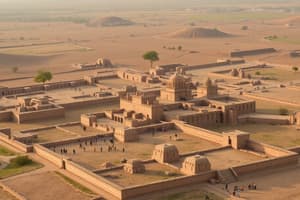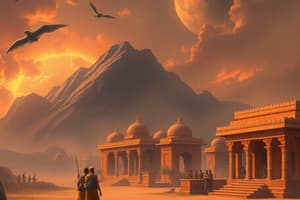Podcast
Questions and Answers
What is the approximate time frame during which the Harappan Civilization is said to have flourished?
What is the approximate time frame during which the Harappan Civilization is said to have flourished?
- 2500 to 2000 BC
- 3000 to 2500 BC
- 3250 to 2750 BC (correct)
- 4000 to 3500 BC
Which of the following locations is NOT considered a major center of the Harappan Civilization?
Which of the following locations is NOT considered a major center of the Harappan Civilization?
- Chennai (correct)
- Dholavira
- Chanhudaro
- Mohenjodaro
What was one of the key features of urban planning in the Harappan Civilization?
What was one of the key features of urban planning in the Harappan Civilization?
- Use of mud huts
- Narrow, winding streets
- Wide roads intersecting at right angles (correct)
- Interconnected low-rise buildings
What materials were commonly used for seals in the Harappan civilization?
What materials were commonly used for seals in the Harappan civilization?
Which statement accurately reflects the social structure of the Harappan Civilization?
Which statement accurately reflects the social structure of the Harappan Civilization?
Which of the following is true about the Harappan script?
Which of the following is true about the Harappan script?
What evidence indicates that the Harappan people practiced irrigation?
What evidence indicates that the Harappan people practiced irrigation?
Which of the following was a predominant occupation among the people of the Harappan Civilization?
Which of the following was a predominant occupation among the people of the Harappan Civilization?
In what way did the Harappan civilization regulate exchange?
In what way did the Harappan civilization regulate exchange?
What type of worship was practiced by the Harappan Civilization's people?
What type of worship was practiced by the Harappan Civilization's people?
Which of the following food animals were domesticated by the Harappan people?
Which of the following food animals were domesticated by the Harappan people?
What remains undeciphered from the materials associated with the Harappan Civilization?
What remains undeciphered from the materials associated with the Harappan Civilization?
Which of the following materials was NOT typically excavated from the sites of the Harappan Civilization?
Which of the following materials was NOT typically excavated from the sites of the Harappan Civilization?
What specialized craft production activity was Chanhudaro known for?
What specialized craft production activity was Chanhudaro known for?
Which evidence do archaeologists use to explore social differences among the Harappan people?
Which evidence do archaeologists use to explore social differences among the Harappan people?
How did the Harappan civilization signify the identity of the sender in communication?
How did the Harappan civilization signify the identity of the sender in communication?
Around which year did the decline of the Indus Valley Civilization become evident?
Around which year did the decline of the Indus Valley Civilization become evident?
Which archaeologist was the first Director General of the Archaeological Survey of India?
Which archaeologist was the first Director General of the Archaeological Survey of India?
What is the time period during which the Harappan Civilization existed?
What is the time period during which the Harappan Civilization existed?
What is another name for the Indus Valley Civilization?
What is another name for the Indus Valley Civilization?
Which factors are suggested as reasons for the decline of the Harappan Civilization?
Which factors are suggested as reasons for the decline of the Harappan Civilization?
Which of the following cities is NOT associated with the Harappan Civilization in India?
Which of the following cities is NOT associated with the Harappan Civilization in India?
What type of artifacts do archaeological studies of the Harappan Civilization primarily rely on?
What type of artifacts do archaeological studies of the Harappan Civilization primarily rely on?
What misconception did Cunningham hold regarding Indian history?
What misconception did Cunningham hold regarding Indian history?
What was a primary characteristic of the settlements like Nageshwar and Balakot?
What was a primary characteristic of the settlements like Nageshwar and Balakot?
How did the Harappans usually obtain raw materials for crafts?
How did the Harappans usually obtain raw materials for crafts?
What role did trade play in the Harappan civilization?
What role did trade play in the Harappan civilization?
What type of worship practices were prevalent among the Harappan people?
What type of worship practices were prevalent among the Harappan people?
What was a significant factor contributing to the end of the Harappan civilization?
What was a significant factor contributing to the end of the Harappan civilization?
In relation to social structure, what was notable about the Harappan civilization?
In relation to social structure, what was notable about the Harappan civilization?
Which decorative motif was used on seals by the Harappans?
Which decorative motif was used on seals by the Harappans?
What significant feature of urban planning was observed in Mohenjodaro?
What significant feature of urban planning was observed in Mohenjodaro?
Which statement about the relative sizes of settlements in the Harappan civilization is accurate?
Which statement about the relative sizes of settlements in the Harappan civilization is accurate?
What term is used to describe the study of historical layers?
What term is used to describe the study of historical layers?
What type of public structures did the Harappans construct in Mohenjodaro?
What type of public structures did the Harappans construct in Mohenjodaro?
What does the term 'Proto-Shiva' refer to?
What does the term 'Proto-Shiva' refer to?
What was the main function of a granary in Harappan civilization?
What was the main function of a granary in Harappan civilization?
Which event marked the beginning of formal archaeological study of the Harappan sites?
Which event marked the beginning of formal archaeological study of the Harappan sites?
Which significant structure is known as the most famous building in Mohenjodaro?
Which significant structure is known as the most famous building in Mohenjodaro?
What were shamans believed to possess in the Harappan civilization?
What were shamans believed to possess in the Harappan civilization?
Flashcards
Indus Valley Civilization dates
Indus Valley Civilization dates
The Indus Valley Civilization flourished between 2600 BC and 1900 BC, peaking around 2600-1900 BC.
Indus Valley Civilization decline
Indus Valley Civilization decline
The Indus Valley Civilization experienced a significant decline around 1900 BC, with major cities like Mohenjo-daro and Harappa falling into disuse.
Harappan Civilization
Harappan Civilization
Another name for the Indus Valley Civilization, encompassing the sites of Harappa and other settlements.
Bronze Age Civilization
Bronze Age Civilization
Signup and view all the flashcards
Archaeological Evidence
Archaeological Evidence
Signup and view all the flashcards
Early and Late Harappan Cultures
Early and Late Harappan Cultures
Signup and view all the flashcards
Cunningham's View
Cunningham's View
Signup and view all the flashcards
Harappan Civilization Artifacts
Harappan Civilization Artifacts
Signup and view all the flashcards
Harappan Seals
Harappan Seals
Signup and view all the flashcards
Harappan Script
Harappan Script
Signup and view all the flashcards
Harappan Weights
Harappan Weights
Signup and view all the flashcards
Harappan Diet
Harappan Diet
Signup and view all the flashcards
Harappan Agriculture
Harappan Agriculture
Signup and view all the flashcards
Social/Economic Differences (Harappan)
Social/Economic Differences (Harappan)
Signup and view all the flashcards
Harappan Craft Production
Harappan Craft Production
Signup and view all the flashcards
Harappan Civilization
Harappan Civilization
Signup and view all the flashcards
Indus Valley Civilization
Indus Valley Civilization
Signup and view all the flashcards
Chronology of Harappan Civilization
Chronology of Harappan Civilization
Signup and view all the flashcards
Mohenjo-daro and Chanhu-daro
Mohenjo-daro and Chanhu-daro
Signup and view all the flashcards
Kalibangan, Lothal...
Kalibangan, Lothal...
Signup and view all the flashcards
Urban Planning
Urban Planning
Signup and view all the flashcards
Drainage System
Drainage System
Signup and view all the flashcards
No Caste System
No Caste System
Signup and view all the flashcards
High Status of Women
High Status of Women
Signup and view all the flashcards
Agriculture and Animal Husbandry
Agriculture and Animal Husbandry
Signup and view all the flashcards
Well-Developed Trade
Well-Developed Trade
Signup and view all the flashcards
Religious Beliefs
Religious Beliefs
Signup and view all the flashcards
Arts and Crafts
Arts and Crafts
Signup and view all the flashcards
Seals
Seals
Signup and view all the flashcards
Undeciphered Script
Undeciphered Script
Signup and view all the flashcards
Archaeological Evidence
Archaeological Evidence
Signup and view all the flashcards
Shell Object Centers
Shell Object Centers
Signup and view all the flashcards
Craft Production Centers
Craft Production Centers
Signup and view all the flashcards
Harappan Material Sourcing
Harappan Material Sourcing
Signup and view all the flashcards
External Trade
External Trade
Signup and view all the flashcards
Harappan Civilization's Economic Life
Harappan Civilization's Economic Life
Signup and view all the flashcards
Harappan Trade
Harappan Trade
Signup and view all the flashcards
Harappan Religious Beliefs
Harappan Religious Beliefs
Signup and view all the flashcards
Caste System's Absence
Caste System's Absence
Signup and view all the flashcards
Women's High Position
Women's High Position
Signup and view all the flashcards
Mohenjo-daro (City)
Mohenjo-daro (City)
Signup and view all the flashcards
Citadels and Cities
Citadels and Cities
Signup and view all the flashcards
Harappan Drainage
Harappan Drainage
Signup and view all the flashcards
Mohenjo-daro Houses
Mohenjo-daro Houses
Signup and view all the flashcards
Mohenjo-daro Wells
Mohenjo-daro Wells
Signup and view all the flashcards
Public Structures
Public Structures
Signup and view all the flashcards
End of Harappan Civilization
End of Harappan Civilization
Signup and view all the flashcards
Late Harappan/Successor Cultures
Late Harappan/Successor Cultures
Signup and view all the flashcards
Causes of Harappan Decline
Causes of Harappan Decline
Signup and view all the flashcards
Seal (Harappan)
Seal (Harappan)
Signup and view all the flashcards
Hoarding (Harappan)
Hoarding (Harappan)
Signup and view all the flashcards
Stratigraphy
Stratigraphy
Signup and view all the flashcards
Motif (Harappan)
Motif (Harappan)
Signup and view all the flashcards
Proto-Shiva
Proto-Shiva
Signup and view all the flashcards
Linga
Linga
Signup and view all the flashcards
Shamans
Shamans
Signup and view all the flashcards
Art (Harappan)
Art (Harappan)
Signup and view all the flashcards
Culture (Archaeology)
Culture (Archaeology)
Signup and view all the flashcards
Pictograms
Pictograms
Signup and view all the flashcards
Great Bath
Great Bath
Signup and view all the flashcards
Granary
Granary
Signup and view all the flashcards
Study Notes
Harappan Civilization
- This is the oldest civilization in India
- There's no single timeline for the civilization. Different scholars have different dates
- Flourished between 3250 and 2750 BCE, according to Sir John Marshall
- Discovered in 1921 by Daya Ram Sahni
- Major centers are in Pakistan (Mohenjodaro and Chanhudaro) and India (Kalibangan, Sangol, Pangplore, Lothal, Dholavira, Banavali)
- Urban planning was advanced, with wide roads intersecting at right angles and well-planned drainage systems
- People lived with mutual love and understanding
- No caste system existed
- Main occupations: agriculture and animal husbandry
- Trade was well-developed (internal and external)
- Worshipped various gods and goddesses (Mother Goddess, Lord Shiva, animals, birds, trees, and the Sun)
- Skilled in arts and crafts (sculptures, toys, pottery, jewelry)
- Used seals with writing systems that are still being deciphered
Archaeological Evidence
- Excavations of Indus sites provide information about tools, pottery, and household items.
- Archaeological evidence (artifacts) show the types of tools, seals, jewelry, houses etc. used by the people.
- The civilization dates back to between 2600 and 1900 BCE
- There were Early and Late Harappan cultures
- Important archaeologists: Cunningham, Daya Ram Sahni, Rakhal Das Banerjee, John Marshall
Decline of the Civilization
- Signs of decline around 1900 BCE
- Two major cities (Mohenjodaro and Harappa)- completely declined
- Possible causes: change in the course of the Indus River, excessive floods, earthquakes, epidemics, invasion by the Aryans
Social and Economic Differences
- Differences between people are studied using archaeological techniques.
- Valuable materials were concentrated in larger settlements
- The Harappan people primarily engaged in agriculture.
- Traded with other cultures
- Economic life was prosperous
- Crafted beautiful sculptures and decorative items
Studying That Suits You
Use AI to generate personalized quizzes and flashcards to suit your learning preferences.




